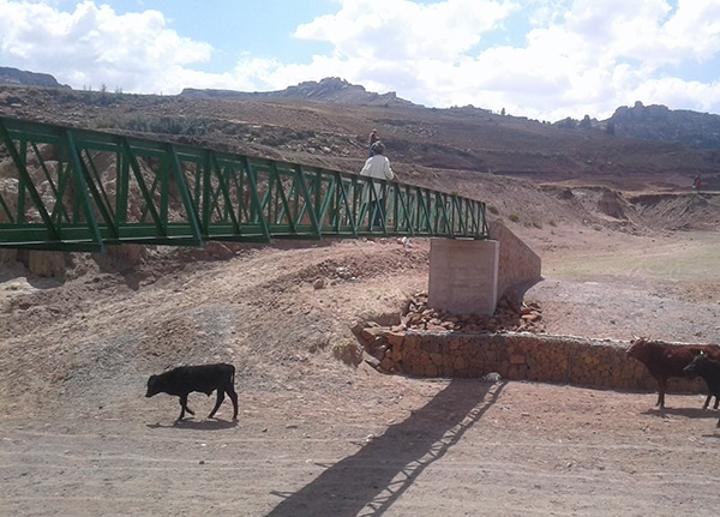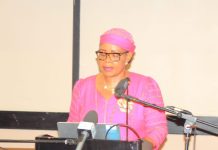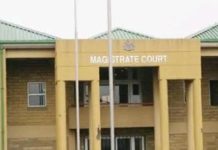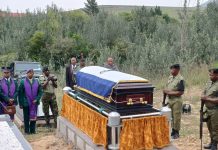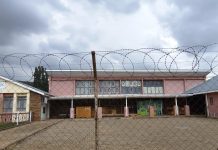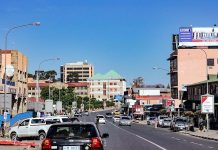Africa-Press – Lesotho. Close to 10 years ago, the two villages of Ha-Seetsa and Ha-Mpetsane in Fobane, Leribe district were mourning the untimely death of two school children who drowned while trying to cross a river that separates the two villages.
On their way from school, the two young boys were trying to cross the Motinyane river in order to get home on that rainy day. Unfortunately, they both could not make it back home after their lives ended in the river which they had crossed almost every day to and from the only nearby Seetsa Primary School.
Almost a decade later, villagers in this area still remember the fateful incident as if it happened yesterday. “One of them died on the scene of the accident while the other died later.
We were running across the flowing river hoping for a miracle that could save their lives but unfortunately we failed. “It was during the rainy season and our children had to cross this river almost every day on their way to Seetsa Primary School.
There were no any other alternative routes to the school and the clinic on the other side of the river,” said Tomas Rets’elisitsoe Kometsane, an old man from the Ha-Mpetsane village.
Since that day, he said, parents from the village are now reluctant to take their children to the popular and only nearby primary school in the area. Some children ended up not going to school on time while others were forced to travel very long distances to attend classes at another school far from the village.
The two villages of Ha-Mpetsane and Ha-Seetsa are very close to each other and are only separated by the Motinyane River. People in these villages work together and share almost all essential services such as clinics, schools and churches.
All these services are on the side of the Ha-Seetsa area. But because of the river, those from Ha-Mpetsane now seldom benefit from all the essential services and some have since quit seeking services from the other side.
They have resorted to travelling long distances to seek services elsewhere. The poor infrastructure in these remote areas also means little or absolutely no economic activity.
Road infrastructure dominates Lesotho’s transport network, making up more than 70 percent of domestic transport needs. Lesotho’s rugged topography has made the development of roads and other infrastructure a challenge.
While this has had significant implications for transport modes and accessibility, the creation of an integrated transport system remains central to government’s infrastructure development programmes.
Relatively few rural roads connect villages and towns in highland districts of Lesotho, which, according to the World Bank, constitute 75 percent of the country’s territory and have high agricultural potential in animal and crop farming and production.
In these areas, a network of bridle paths, footbridges and river crossings provides some access to the main roads and to basic services such as schools and health centres, but this access remains limited and is further impeded by floods and landslides during heavy rainfall.
Thanks to the World Bank in partnership with the Government of Lesotho, communities in the area, particularly those coming from the Ha-Mpetsane area, will now be able to access all the essential services on the other side.
Under their Transport Infrastructure and Connectivity Project, the World Bank has built a foot bridge that will connect the two areas at all times, even during the rainy season. The 21-metre bridge, which cost the World Bank US$62, 613 (nearly M1 million), will serve more than 800 people in the area.
On Thursday last week, the World Bank’s country director to Lesotho Jenet Entwistle and other government officials visited the area to oversee the opening of the bridge and to also see whether funds have been spent properly.
“Today is a joyful experience. Since 2015 I have been working with colleagues and government towards the financing of this bridge. It takes a lot of planning and resources but I am thrilled with the support we have received.
“Children and pregnant women drown on their way to and from hospitals during rains and floods but thankfully this area will now be saved through this bridge.
“I should point out that we are committed to working with government in building bridges of this nature across the country in order to assist where we can,” Entwistle said while delivering her remarks last week.
The Principal Secretary in the ministry of Development Planning, Nthateng Lebona, speaking on behalf of the government said the bridge will go a long way towards assisting local communities to move freely without any interference.
“This is a big thing and I am happy for the people here because now it means their suffering is over, thanks to the World Bank. We are working closely with them on this project. This bridge will definitely bring more development in this area, particularly those that could not be achieved without the bridge,” Lebona said.
The Transport Infrastructure and Connectivity Project is financed by the World Bank to the tune of US$18.3 million to address rural accessibility to social services, agricultural centres and job markets through provision of infrastructure links that are safe and sustainable connecting the targeted areas in Lesotho.
This will be realised by improving access through construction of footbridges and strengthening the capacity of transport institutions to improve road safety management and tackle the maintenance of the transport infrastructure.
There are 35 footbridges to be constructed that will directly benefit rural residents by improving their access to agricultural and job markets, health and educational services and other services such as administration and police offices.
The project will generate about 500 jobs for the local population, both women and men in the construction works. The footbridge designs will be prepared factoring in the needs of women and girls, men and boys as well as the disabled and elderly living in the surrounding communities.
Up to 33 of the bridges, the World Bank reported, are simple template design structures that can be erected quickly and without the need for costly customisation.
The other two bridges are larger structures requiring specialist designs and more complex construction methods. All the bridges are expected to be completed by the end of calendar year 2020.
For More News And Analysis About Lesotho Follow Africa-Press

